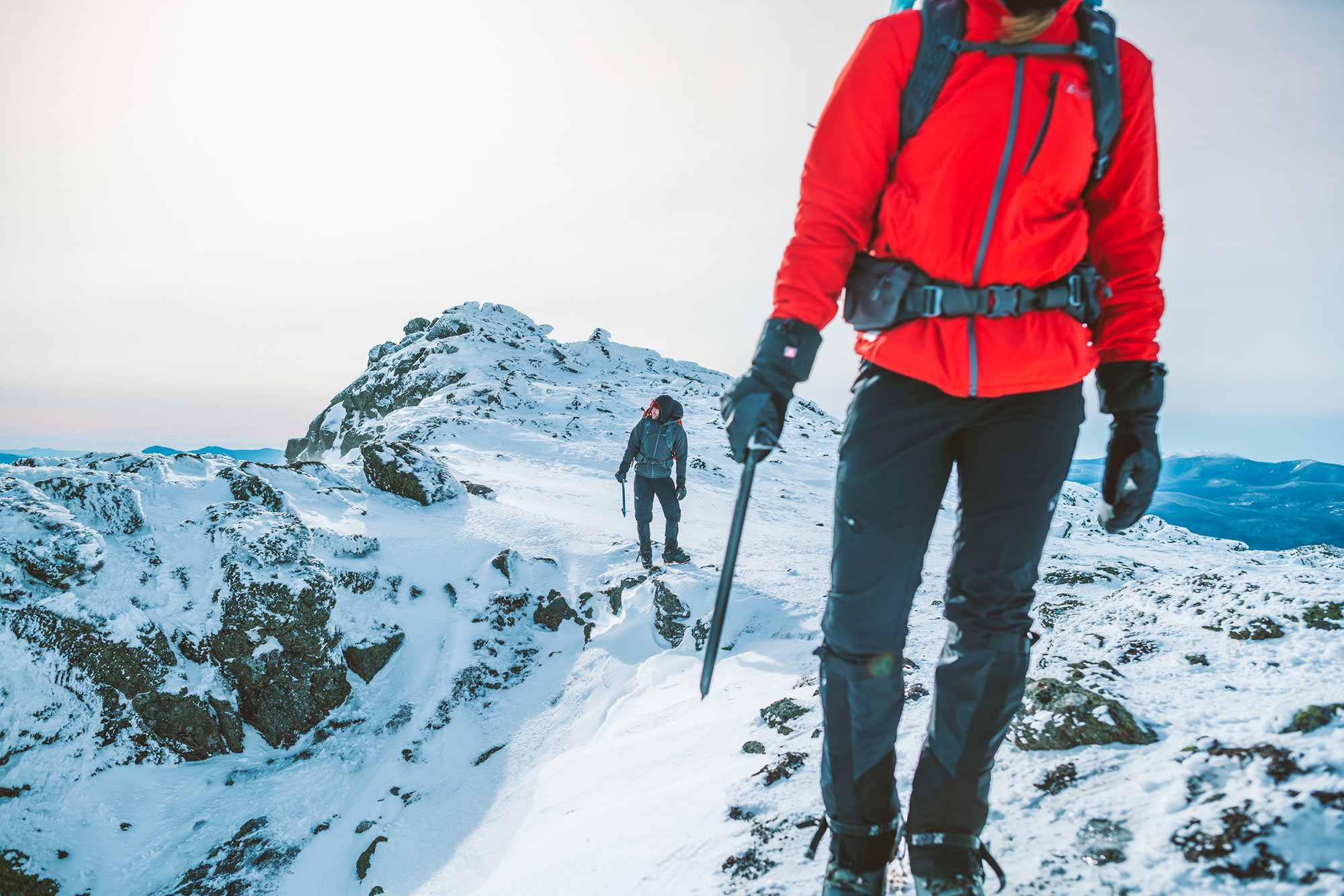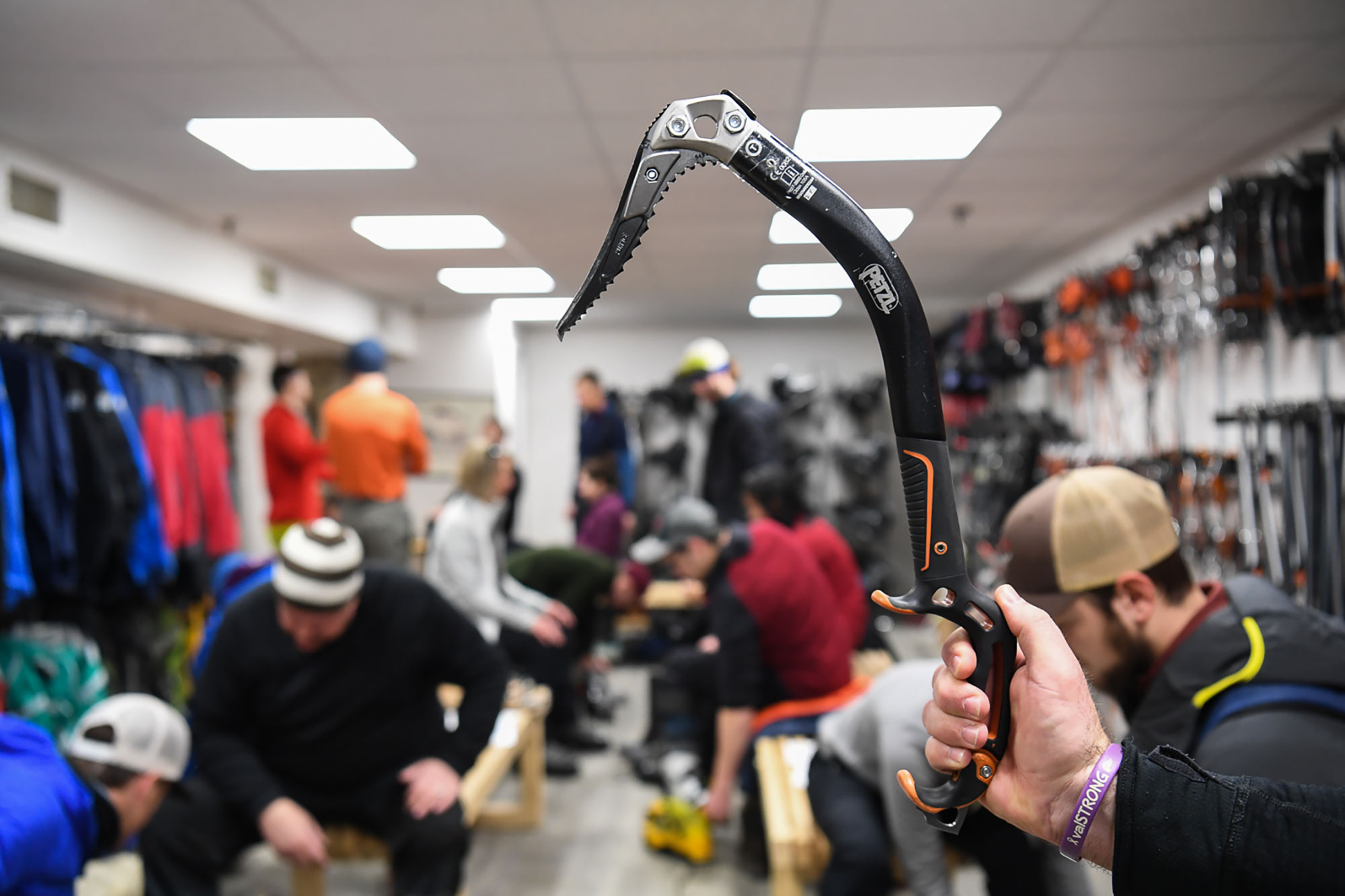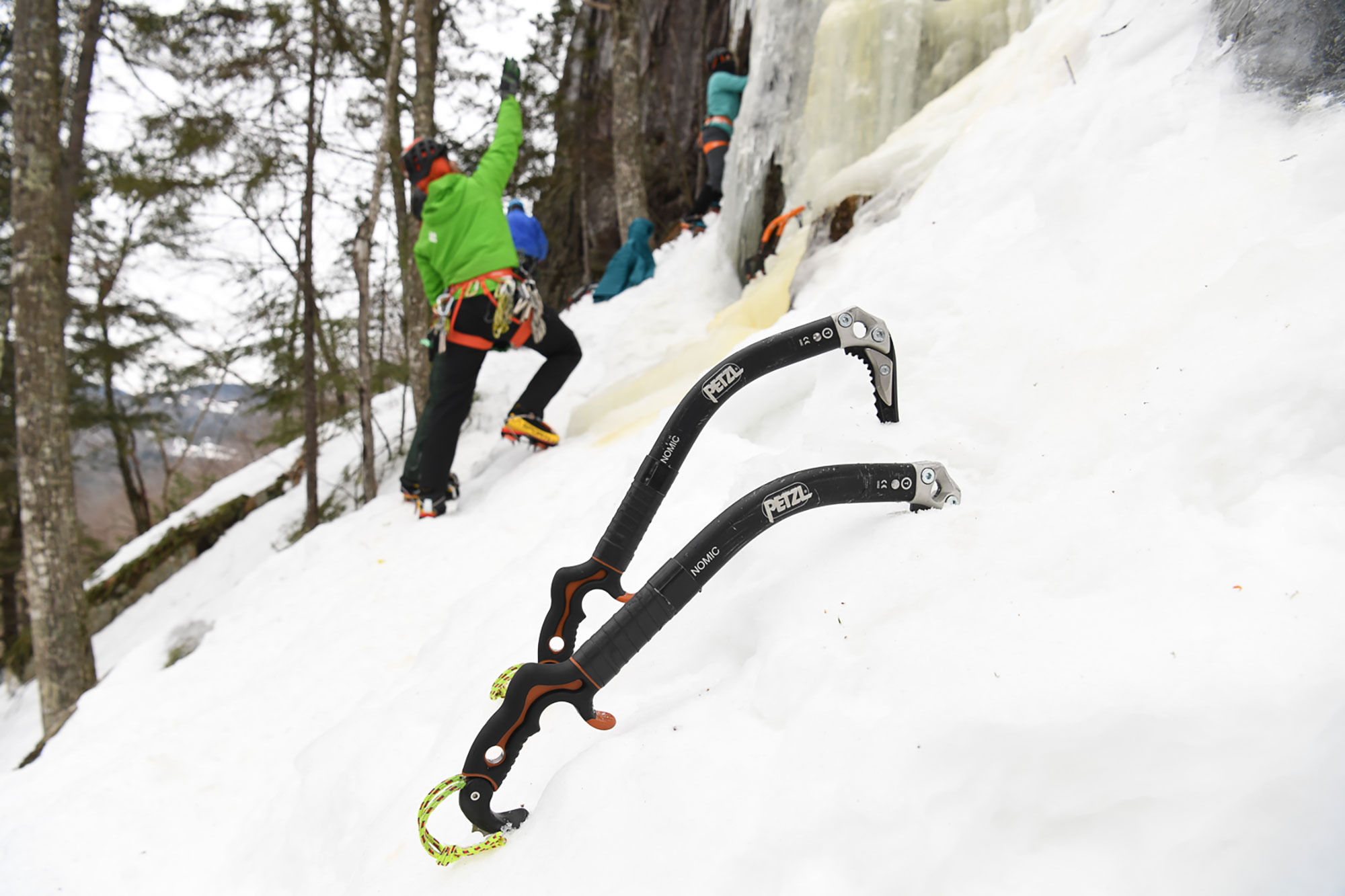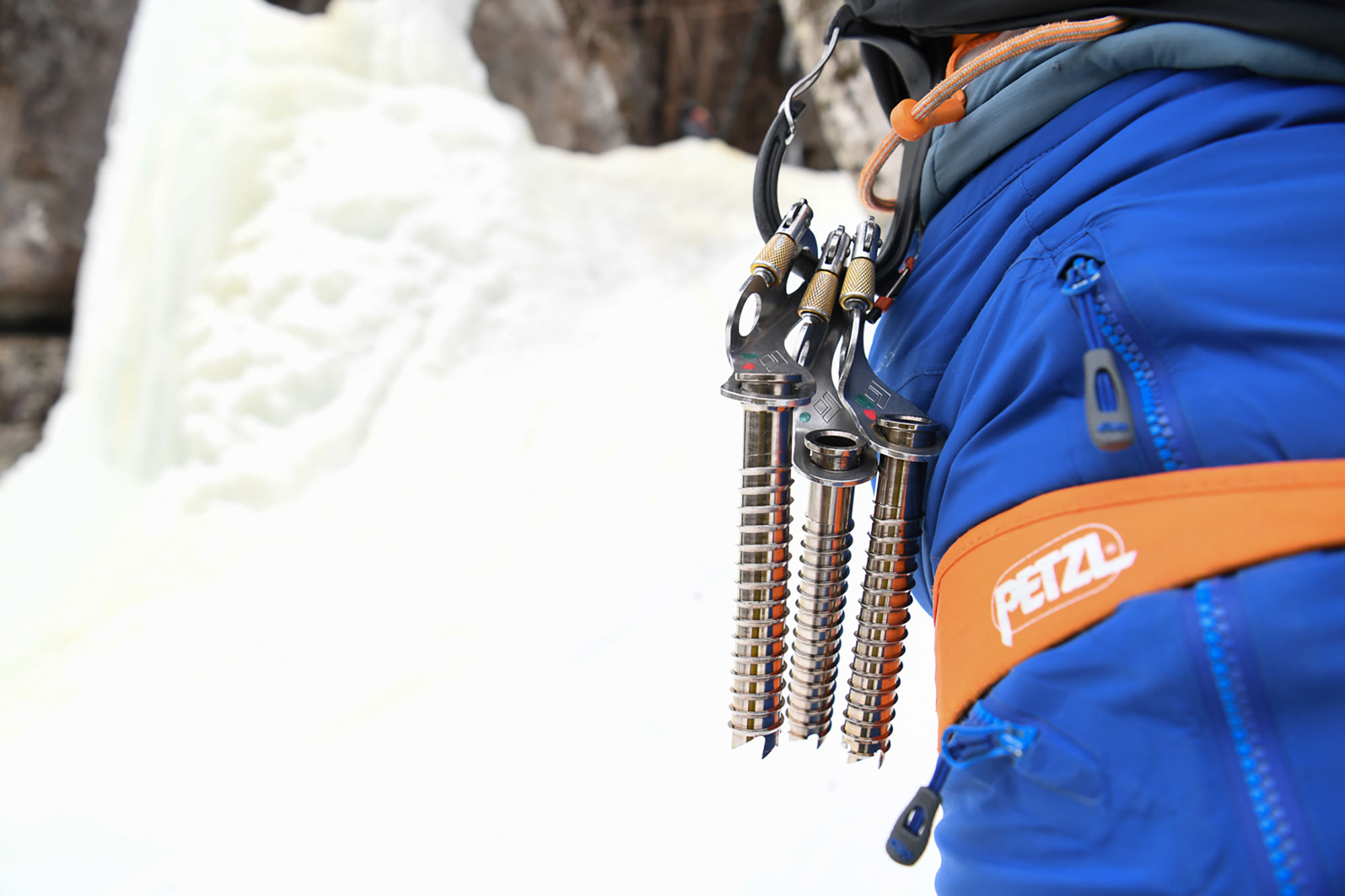Whether you’re a rock climber thinking about giving ice a try, a winter hiker looking to greater heights, or a skier with eyes on deeper backcountry, you’re going to need an ice axe to take it to that next level. They are a critical tool for safety and stability in steep winter terrain and open the floodgates to bigger mountain objectives. While the options out there may seem overwhelming, a little bit of background on the anatomy of an ice axe is all you need to find the right one for your objectives.

Types of Ice Axes
Broadly speaking, there are three types of ice axes: mountaineering axes, technical ice tools, and a spectrum of semi-technical axes covering everything in-between.
Mountaineering Axe
When most folks think of an ice axe, what they picture is a traditional mountaineering axe: an asymmetric head, with a curved pick on one end and an adze on the other, mounted atop a long, straight shaft that ends with a sharp point. These days, the shafts have gotten shorter and some deploy a bit of a curve, but the intent of their design is the same: During non-technical travel on glaciers and high alpine snowfields, they are incredibly useful as a third point-of-contact, for building anchors, and for self-arresting after a fall. If you’re looking to tackle Mount Washington’s Lion Head Winter Route, a mountaineering axe is what you’re after.
Ice Tools
Ice tools main function is climbing steep, technical ice. Aside from being used in pairs, the principal difference between ice tools and other types of ice axes is the aggressive pick and a curved shaft—both designed with steep terrain in mind and more overhead swinging into hard ice than plunging the staff into snow. The head of an ice tool is asymmetrical, and may or may not have an adze or a hammer opposite the pick. The most common set-ups you’ll see in a pair of ice tools are adze/hammer or just picks. For steep ice from Crawford Notch to Stony Clove, a pair of technical ice tools is the way to go.
Everything in Between
The spectrum of options that exists between mountaineering axes and ice tools is difficult to define, but they are invariably designed for utility and efficiency. To that end they will usually take on the qualities of both mountaineering axes and ice tools in incremental degrees. These “hybrid” or “alpine” axes are excellent for long jaunts into the high backcountry where one may encounter anything from snowfields to steep ice.

Parts of an Ice Axe
The anatomy of an ice axe can be broken down into four main parts: the head, the shaft, the grip, and the spike. The characteristics of these parts, designed with specific use cases in mind, are what differentiate one axe from the next.
Head
The head of an ice axe can be further broken down into three parts: a pick, an adze or a hammer, and a carabiner hole. It’s common for the heads of mountaineering axes to be cast from a single piece of metal, where as ice tools are modular, allowing for a greater degree of customization. All of these, however, are subject to a “B” or a “T” rating. The ratings are given based on tests performed on ice axes assessing their durability against the forces commonly found in mountaineering. Simplified, a “T” rating is stronger, and more reliable when subjected to the punishment of steep ice climbing or dry-tooling on rock. A “B” rating is more than sufficient for most general mountaineering purposes and may be lighter.
Pick
Picks come in two basic styles: classic or reverse curved. Classic curved picks are ubiquitous on the traditional mountaineering axe and are superior for self-arresting after a fall and for plunging into steep snow with the hand on the head of the axe. Reverse curved picks, on the other hand, are far more effective biting into ice when swinging a tool on steep terrain.
Adze/Hammer
Opposite the pick of an ice axe you can expect to find an adze, a hammer, or nothing at all. More often than not, mountaineering axes are adorned with an adze, a sharp, horizontal piece not unlike a spade. This is a very useful tool for digging an anchor, or cutting a platform for a bivy or a tent on an uneven surface. Back before the advent of modern crampons, these were used to cut steps up steep slopes.
Adzes are also found on ice tools—typically on one of the pair—and can be used in the same way, which is handy on longer alpine objectives that may include a mix of low-angle terrain and steep, technical ice.
In those circumstances, the tool opposite the adze will have a hammer. Hammers are great for banging protection into rock, clearing out ice from around fixed gear, and setting snow pickets on steep, snowy routes.
Ice tools intended for shorter outings on single- or multi-pitch waterfall ice often have neither an adze nor a hammer.
Carabiner Hole
Directly above the shaft of an ice axe is a hole cast into the head. This hole can be used to tether a mountaineering axe to its user or to rack an ice tool on a harness. It’s pretty common on the former, and ubiquitous on the latter.

Shaft
After the head, the shaft of an ice axe is the most important determining factor of the intended use of an ice axe. Shafts are similarly rated as “B” or “T” and can be subcategorized based on two characteristics: their shape and their length.
Curve
The silhouette of an ice axe’s shaft is likely it’s most nuanced and varied characteristic, defined not by an either/or but rather a spectrum of curves and bends dependent on the needs of the user. At one end, the traditional mountaineering axe maintains its straight profile—excellent for use as a cane–while at the other end the shaft of an ice tool has an aggressive curve—which makes penetrating hard ice easier and relieves fatigue while weighting a tool on steep terrain. In between, several mountaineering axes have adopted a curved shaft to keep the user’s hands out of the snow on steeper snow slopes—where gripping the axe mid-shaft and plunging the pick into the snow makes for efficient travel. Similar variety can be found in some ice tools which have a gentler curve, which allows for more utility in more varied terrain.
Length
While ice tools are a bit of a one-size-fits-all thing, the length of a mountaineering axe is largely dependent on the height of a user. When sizing a mountaineering axe, let your arm hang by your side and measure from the base of your thumb to your ankle. That measurement will directly correspond to the size mountaineering axe that you need. Most mountaineering axes come in varying sizes.

Grip
For technical ice tools, the design of the grip is another important consideration to take. All ice tools have ergonomic rests at the base of the grip, but many also have one at the top: this is there for matching or switching hands on a traverse, or to help pull up and over steep bulges. The big difference in the grips of ice tools though, is whether or not it’s offset. Offset tools are designed for efficient movement on steep terrain, easing fatigue and keeping the user’s hands from bashing the ice. Regular tools are totally usable on steep terrain, but are excellent on long, moderate alpine climbs, where an offset grip may be more hindrance than help, and utility is key.
Spike
Finally, at the very end of it all, is the spike. All mountaineering axes—and many ice tools—are outfitted with a spike at the bottom of the shaft, meant for plunging into snow and for stability while using the axe as a cane. It’s handy even on ice tools, for both the lengthy backcountry expeditions as and the short, steep approaches you may encounter at the local flow.

Accessories
Your specific objectives as a climber will dictate the axe you ultimately choose. Those objectives will also determine any extras that you may need to effectively and safely use that axe in the field.
Leashes
To use or not use a leash while wielding an ice axe boils down to a simple question: “Am I likely to drop a tool doing this?” If you’re a first-timer climbing steep ice, then it may be a good confidence booster to tether your tools. Even the most hardened of alpinists may leash-up—especially if they’re headed deep into the backcountry, where losing a tool could lead to a dire situation. For vertical ice, a leash that connects to your belay loop rather than your wrist won’t prevent you from switching tools on a traverse. For non-vertical terrain, a wrist leash—which comes stock on many mountaineering axes—will do the trick.
Ice Clippers
Ice clippers are rad little plastic carabiners that, when attached to a compatible harness, are used to rack ice screws. They’re also handy for racking ice tools so your hands are free while rappelling or being lowered down a pitch of steep ice.
Protectors
Protecting your sharps—and everything they may come in contact with, for that matter—is critical, so covering them up should be a no-brainer when your tools aren’t in use.
John Lepak
John Lepak is an art director, graphic designer, and weekend mountaineer. He hasn’t met a rock scramble he didn’t like, and spends his free time either in the mountains or obsessively cooking Mexican food. When John isn’t pushing pixels, crushing miles, or making the best carnitas caseras you’ve ever tasted, you can find him living the dream in the Connecticut woods with his family. Follow him at @jhlepak.




